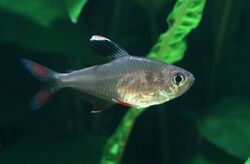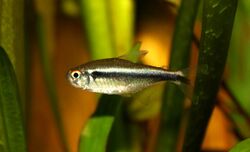Biology:Hyphessobrycon
| Hyphessobrycon | |
|---|---|

| |
| Hyphessobrycon bentosi | |

| |
| Hyphessobrycon herbertaxelrodi | |
| Scientific classification | |
| Domain: | Eukaryota |
| Kingdom: | Animalia |
| Phylum: | Chordata |
| Class: | Actinopterygii |
| Order: | Characiformes |
| Family: | Characidae |
| Subfamily: | incertae sedis |
| Genus: | Hyphessobrycon Durbin, 1908 |
| Type species | |
| Hyphessobrycon compressus Meek, 1904
| |
| Species | |
|
over 150, see text | |
| Synonyms | |
|
Dermatocheir Durbin, 1909 | |
Hyphessobrycon is a genus of freshwater fish in the family Characidae. These species are among the fishes known as tetras. The genus is distributed in the Neotropical realm from southern Mexico to Río de la Plata in Argentina . Many of these species are native to South America; about six species are from Central America and a single species, H. compressus is from southern Mexico.[1]
All small fishes, the Hyphessobrycon tetras reach maximum overall lengths of about 1.7–9.6 cm (0.7–3.8 in).[1] Great anatomical diversity exists in this genus.[2] They are generally of typical characin shape, but vary greatly in coloration and body form, many species having distinctive black, red, or yellow markings on their bodies and fins. These species are generally omnivorous, feeding predominantly on small crustaceans, insects, annelid worms, and zooplankton. When spawning, they scatter their eggs and guard neither eggs nor young.
Taxonomy
This large genus of characins includes over 150 species.[1] The systematics of Hyphessobrycon are still largely unresolved.[3] Six groups within this genus have been recognized based on color patterns alone.[4] With no phylogenetic analysis of this genus, species are placed into this genus as anatomically defined by Carl H. Eigenmann in 1917.[2] By this definition, Hyphessobrycon is identified by the presence of an adipose fin, incomplete lateral line, two tooth series in the premaxilla, with the teeth of the external series continuous in a single series, teeth not strictly conical, preventral scales arranged in more than one row and lack of scales in the caudal fin.[2] The characteristic of extension of scales onto the caudal fin that differentiates this genus from Hemigrammus is not satisfactory, as it occurs in intermediate conditions.[2]
This genus is not monophyletic.[2] A monophyletic group within Hyphessobrycon has been hypothesized, termed the rosy tetra clade; this group is based upon coloration pattern and the shape of dorsal and anal fins of males.[4] Recognition of monophyletic groups among Hyphessobrycon species is complicated by the difficulty in finding characters useful for hypothesis of relationships among the species.[4] Traditional characters used to identify Hyphessobrycon are phylogenetically unreliable.[4]
Etymology
The generic name, Hyphessobrycon, is of slightly uncertain origin. The second part derives from the Greek βρύκω (to bite); the first, derives from an ostensible Greek hyphesson, which may be an error for υπελάσσων (slightly smaller).[1]
Relationship to humans

Most of the 144 species in the genus have not been rated by the IUCN Red List as a threatened, but many species have small distributions and at least three, H. flammeus,[5] H. coelestinus and H. duragenys are classified as endangered.[7] One, H. taurocephalus, is categorised as possibly extinct.[5][8] This species only occurs in a few rivers and streams in Santa Catarina and Paraná states of Brazil.
Many Hyphessobrycon species are popular aquarium fish, and some, including H. flammeus, are bred in large numbers in captivity.[6][9]
Species
The 156 currently recognized species in this genus are:
References
- ↑ 1.0 1.1 1.2 1.3 Froese, Rainer and Pauly, Daniel, eds. (2017). Species of Hyphessobrycon in FishBase. June 2017 version.
- ↑ 2.0 2.1 2.2 2.3 2.4 Lucena, C.A.S.d. (2003): New characid fish, Hyphessobrycon scutulatus, from the rio Teles Pires drainage, upper rio Tapajós system (Ostariophysi: Characiformes: Characidae). Neotropical Ichthyology, 1 (2): 93–96.
- ↑ Lima, F.C.T. & Moreira, C.R. (2003): Three new species of Hyphessobrycon (Characiformes: Characidae) from the upper rio Araguaia basin in Brazil. Neotropical Ichthyology, 1 (1): 21–33.
- ↑ 4.0 4.1 4.2 4.3 Bertaco, V.A. & Malabarba, L.R. (2005): A new species of Hyphessobrycon (Teleostei: Characidae) from the upper Rio Tocantins drainage, with bony hooks on fins. Neotropical Ichthyology, 3 (1): 83–88.
- ↑ 5.0 5.1 5.2 Carvalho, F.R., Jesus, G.C.d. & Langeani, F. (2014): Redescription of Hyphessobrycon flammeus Myers, 1924 (Ostariophysi: Characidae), a threatened species from Brazil. Neotropical Ichthyology, 12 (2): 247-256.
- ↑ 6.0 6.1 Hyphessobrycon flammeus Myers, 1924 Flame Tetra. Seriously Fish. Retrieved 21 March 2017.
- ↑ ICMBio (Ministry of the Environment, Brazil): Portaria MMA nº 445, de 17 de dezembro de 2014 . Lista de Especies Ameaçadas - Saiba Mais. Retrieved 1 December 2018.
- ↑ Instituto Chico Mendes de Conservação da Biodiversidade (ICMBio) (2022). "Hyphessobrycon taurocephalus". IUCN Red List of Threatened Species 2022: e.T187279A1825804. doi:10.2305/IUCN.UK.2022-1.RLTS.T187279A1825804.pt. https://www.iucnredlist.org/species/187279/1825804.{{cite iucn}}: error: malformed |doi= identifier (help)
- ↑ Korotev, K. (2017): Breeding Hyphessobrycon flammeus. AquaInfo. Retrieved 21 March 2017.
Wikidata ☰ Q132810 entry
 |

